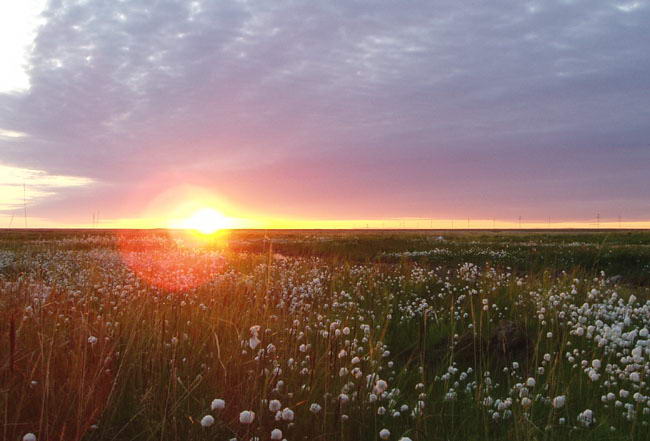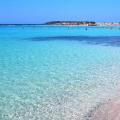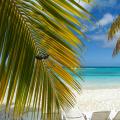LANDSCAPE MOSAIC
TUNDRA
If you look at a color photograph of Russia from space or at its landscape map, you will immediately notice that there is a vast treeless zone to the north of the Arctic Circle. It basically repeats the bizarre outlines of the freezing Arctic Ocean.
The entire northern coast of Russia, except for the coast Of the White Sea, occupies a treeless area - tundra. Why doesn't a forest grow in the tundra? Three main reasons hinder its growth - cold and short summers, strong winds and high air humidity. In addition, there are many swamps in the tundra. Snow is blown off from high places, and the soil freezes so much that it does not have time to thaw in summer. Therefore, permafrost is almost ubiquitous in the tundra. This also does not contribute to the development of woody vegetation. On Kola Peninsula the forest continues for another one or two hundred kilometers to the north of the Arctic Circle. The influence of non-freezing is strong here. Barents Sea, and winter is even warmer than in central Russia. Only a strip of seaside with its winds and fogs remains on the tundra. The low peaks of the hills are also treeless on the peninsula, which the indigenous people - the Sami call tunturi, hence the word "tundra".
Beyond the Urals, in the Asian part, at the edge of the ice seas and cold currents, the tundra extends in a wide strip. Its zone is even more extensive in the northeast of the continent, where even at the latitude of St. Petersburg and Vologda, the summer is very damp, cool and windy.
CLIMATE
V polar latitudes the sun does not rise over the horizon during the long winter months, and the snow cover is from October to June. Moreover, the fierce arctic winds can blow snow off the heights, and in the hollows and valleys, snowdrifts several meters thick can be covered. In the Asian part of the winter, temperatures often drop below -40 ° C; in the European part such frosts are rare and there are even thaws.
The day in the Arctic in spring arrives very quickly, and already in May it is light all day long. On higher elevations and southern slopes, snow melts quickly. In the hollows, it can lay down even until the end of summer - such masses are called snowfields. Melt water quickly flows down the frozen soil into streams and rivers, which are widely spread over the tundra. In the summer they become shallow, especially in Siberia.
Summer in the tundra is short and lasts 2-2.5 months. But the plants receive a lot of light (the sun does not set for several months); they quickly dissolve their leaves, bloom and give seeds. The temperature rarely rises above + 10 ° С, and frosts can hit at any moment. True, there is a thirty-degree heat, but this is an exception. Little rains, thunderstorms and heavy showers, as a rule, do not happen, but it is still very damp due to frequent drizzle, low clouds and fog with chilly wind.
The polar day is ending; autumn comes to the tundra, and with it the cold, ice and snow return. In the west, frosts come gradually, interspersed with thaws. In Siberia, on the contrary, ice immediately grasps water bodies and soil, and usually there is no return to warmth.
NORTHERN PATTERNS
Almost the entire European and West Siberian North, as well as the North Siberian, Yano-Indigirskaya and Kolyma lowlands, the New Siberian Islands are tundras of flat plains. They are covered with clays, loams, river sands. The landscapes are monotonous, with small dry patches lost amid vast swamps. A different look in the mountain tundra, which prevails on the Kola Peninsula, Polar Urals, Taimyr Peninsula, Putorana plateau, uplands Eastern Siberia and Chukotka. The rugged relief and stony placers make the conditions for the existence of flora and fauna, which means that the landscapes are very diverse.
Almost everywhere in the tundra zone, the soil is frozen. The first thing that catches your eye when you first see the tundra from an airplane window is the sparkling mirrors of many bodies of water. These are thermokarst lakes - they were formed as a result of thawing of permafrost and subsidence of the soil.
The northern plains often resemble honeycombs. This is how polygonal tundras look like, which appear as a result of cracks in frozen ground. The shape of the pattern is associated with soil moisture. Hexagonal "cells" appear on not too wet loamy and sandy soils.
In spring and summer, on the slopes of hills, the thawed upper layer of soil slowly, like semolina on an inclined plate, flows down the lower, still frozen layer, tracing stripes and horseshoes along the way.
In the frosty winter, fragments of stones are squeezed out of the ground, and the tundra is covered with rings and polygons. There are small stones in the center, and large ones along the edges.
Life in the tundra adds its own patterns to those drawn by the permafrost. For example, owls and skuas hunting lemmings choose elevated areas for ambush and fertilize the soil with dung. Tall grass grows here, and on a sunny summer day, the grid of bright green dots looks very picturesque from the air.
VEGETATION
Let's mentally cross the tundra zone from south to north. In this direction, the forest on the plain, and above all in the wetlands, disappears, and spots of tundra appear on shallow elevations among the bogs. Gradually "bald patches" become more and more - on the tops of the hills, on the blown slopes. In the end, the forest remains only in the valleys of rivers and streams - the driest and most sheltered from the winds. Although, of course, it is difficult to call the landscape a forest - the trees are so sparse and undersized. On the border with the tundra, they acquire a flag shape (the branches grow on the leeward side protected by the trunk) and are often decorated with "skirts": at the bottom there is a dense growth of branches, which are covered with snow in winter; regular crown.
If you travel not across the plain, but over the mountains, tundra "bald spots" will first appear on the tops of the hills and, as you approach the north, they will descend down the slopes to the river valleys.
In the south, adjacent to the forest, the tundra is similar to the northern taiga, only consisting of one undergrowth, without tall trees. The same green mosses, shrubs of lingonberries, blueberries, chic-shea, a lot of dwarf birches, over which sometimes mushrooms rise - a kind of "supra birch". There are many mushrooms, they are clearly visible; thanks to the cool climate, they remain insensitive for a long time. For a mushroom picker, the tundra is a real paradise.
The tundra is very beautiful twice a year. The first time is in August, when cloudberries ripen and the landscape changes color first from green to red, and then to yellow. The second time is in September, when the leaves of the dwarf birch and shrubs turn yellow and red. .This is "golden autumn" in miniature.
Vegetation in both the southern and middle-position "typical" tundra is most abundant in areas of accumulation of snow. In winter, the snowdrifts shelter the plants from the fierce cold weather and winds, and in the summer, we can do it in their place! you can see tall forbs among the bushes.
In the north of the tundra zone there are already no forests and along the rivers, dwarf birches disappear, fewer Iago / 1.11 dwarf shrubs, but more dwarf willows and dryads - partridge grass. The vegetation cover is dominated by mosses and lichens, although there are quite a few grasses. In Eastern Siberia and on Far East typical so-called kochkarpikons "tundra. Tussocks form sedges and cotton grass - a very characteristic plant for this zone. In English, cotton grass is called cottongrass -" cotton grass. "Indeed, it is a grass with a brush of thin white fiber.
a plant characteristic of this zone. In English, cotton grass is called cottongrass - "cotton grass". Indeed, it is a herb with a fine white fiber tassel.
The traveler also grows on the border of the tundra with the polar deserts. In extremely harsh conditions, snow in hollows and hollows is no longer a friend, but an enemy of vegetation, because it stays for a long time and reduces the period of possible growth to a minimum. Others are here and there are swamps - there are almost no rich sphagnum (deciduous) mosses on them, but sedge is in sufficient quantities. Grasses predominate in elevated areas: cereals, multi-colored saxifrages, purple spiky peaks, yellow polar poppies and buttercups.
The peculiarity of the permafrost relief is reflected in the pattern of the vegetation cover. For example, shrubs, mosses and sedges can grow along permafrost cracks, and the center of the "polygon" is covered only with an algal film or lichens, or completely naked.
The further to the north, the more lifeless spaces, especially on stony placers. Rare plants tend to hide from severe frosts and, above all, to protect the roots from the cold. As if not hoping that they will be able to give seeds every year, these northerners are able to reproduce by rhizomes.
ANIMAL WORLD
In something animal world tundra is similar to forest tundra, but incomparably poorer. You can unexpectedly see through the frozen arctic soils earthworms. It turns out that they form a capsule of mucus that does not freeze at low temperatures, and so they wait out the fierce winter. The tundra has a wide variety of insects. There are also ants that build their dwellings from the hard leaves of shrubs or from the ground.
About mosquitoes and midges need to be said separately. In the tundra, the vile is capable of turning life into a real hell. Deer climb to the blown tops of hills or go down to the coast: only there the wind saves them from blood-sucking insects. There are so many animals on the hills that they knock out the vegetation and tamp the soil to stone hardness, leaving only the lush meadows in the river valleys untouched. In the northernmost tundra, there are almost no mosquitoes, but there are bumblebees, which, even on particularly windy days, collect nectar from brightly colored arctic flowers.
But there are very few people in the tundra - these are amphibians and reptiles. In puddles, sometimes the most primitive of amphibians - salamanders - are found, and representatives of another species live in thickets of bushes - sharp-faced frogs. There are no snakes at all, the only reptile is a viviparous lizard found near the forest belt.
And yet the tundra seems to be full of life. First of all, birds, of which there are a lot, create such an impression. And what birds nest here! Large waterfowl - swans, geese, geese, ducks. They breed offspring in the tundra and then fly away in thousands of flocks to the south, to warm countries... It is impossible to walk several kilometers along the tundra without seeing the partridges fluttering out right from under your feet. A majestic snowy owl froze in a white column on a high mound - looking out for lemmings. Skuas hanging in the air also hunt for these rodents. Small birds are haunted by soaring buzzards, falcons swiftly cutting through the air. Among the smallest birds, the most noticeable are "polar sparrows" - snow buntings, as well as various waders living in numerous flocks.
The main animals of the tundra are lemming, arctic fox and reindeer. Lemming is larger than a mouse, but smaller than a rat. It not only serves as the main food for many animals, in particular the Arctic fox, but also affects the development of soils and vegetation. Lemming burrows help to ventilate the soil, and its excrement favors the growth of grasses near the colonies. Amphibians and insects also overwinter in lemming burrows.
Arctic fox is a small and nimble polar fox. When breeding offspring, these animals dig in the driest places whole labyrinths - "Arctic fox towns", also contributing to the appearance of the tundra. The sly arctic fox can do without lemmings. On Kolguev Island, he perfectly adapted to life, carrying eggs and chicks from the numerous geese here.
Tundra and man
If the aliens saw from space the northern polar region of the Earth, they would find traces of the activity of intelligent beings in vague spots in the area of the cities of Nikel and Monchegorsk on the Kola Peninsula, Vorkuta in the Urals and Norilsk in Taimyr. Large industrial and transport hubs have been created there. But compared to the total area, the territories developed by people make up a small part.
The nature of the North is very vulnerable. Even reindeer herders and hunters upset her delicate balance. The increasing number of oil industry workers are advancing on the tundra: they set up oil rigs, lay oil pipelines and crowd out reindeer herders, which leads to an even greater depletion of the remaining reindeer pastures. Chemical contamination! The same environment in the area of metallurgical enterprises on the Kola Peninsula and in Central Siberia led to the strongest and even in some places complete destruction of natural landscapes. And as a result of nuclear tests in the atmosphere, the tundra zone of Russia has experienced tremendous stress and has only recently returned to normal. In addition, due to the direction of air currents, "mud" from the southern latitudes rushes to the northern ones. As a result, the tundra suffers from many substances that have never been produced or used in this area, such as pesticides (see the article "Environmental pollution").
At the same time, with the exception of the environs of rather uncomfortable polar settlements and mining areas, the tundra of Russia has not yet been changed by man.
Not flooded with sea or river waters. By the nature of the surface, the tundra can be rocky, clayey, sandy, peaty, hummocky or. The idea of the tundra as a hard-to-reach space is true only for swampy tundra, where permafrost may disappear by the end of summer. In the tundra of European Russia, the thawed layer reaches, by September on peat about 35 cm, on clay about 132 cm, on sand about 159 cm depth about 52 - 66 cm.
After very frosty and little snowy winters and in cold summers, the permafrost, of course, is closer to the surface, while after mild and snowy winters and in warm summer the permafrost is sinking. In addition, on level ground, the thawed layer is thinner than on slopes, where permafrost may even disappear completely. On, and along the coast of the Czech Bay to the Timan Ridge, peaty-hilly tundra dominates.
The tundra surface here consists of large, about 12-14 m high and up to 10-15 m wide isolated, steep, extremely dense peat bogs, frozen inside, hillocks. The intervals between the hillocks, about 2 - 5 m wide, are occupied by a very watery, inaccessible swamp, the "ersei" of the Samoyeds. The vegetation on the mounds consists of various lichens and mosses, usually with cloudberries on the slopes. The body of the hillock is composed of moss and small tundra shrubs, which sometimes even predominate.

The peat-bumpy tundra passes to the south or closer to the rivers, where there are already forests, into sphagnum peat bogs with cranberries, cloudberries, gonobol, bagun, and birch dwarf birch. Sphagnum peat bogs jut very far into the forest area. To the east of the Timan ridge, peat mounds and ersei are already rare and only in small areas in low places, where more water accumulates. In the northeast of the European and in the developed the following types of tundra.
Peaty tundra. The peat layer, consisting of mosses and tundra shrubs, is continuous, but thin. The surface is covered mainly with a carpet of reindeer lichens, but cloudberries and other small shrubs are sometimes found in abundance. This type, developed on more even places, is very widespread, especially between Timan and.
Bald, fractured tundra very common in places that do not present conditions for stagnant water and are accessible to action, blowing off snow and drying up, which is covered with cracks. These cracks break the soil into small (about a plate, a wheel, and larger) areas, completely devoid of vegetation, so that frozen clay or frozen sand protrude outward. Such sites are separated from each other by strips of small shrubs, grasses and saxifrage sitting in cracks.
Herb and artisanal tundra develops where the soil is more fertile. Lichens and mosses recede into the background or disappear completely, and shrubs dominate.
Bumpy tundra. Bumps up to 30 cm in height consist of cotton grass with mosses, lichens and tundra shrubs. The gaps between the bumps are occupied by mosses and lichens, and the gray-haired lichens also dress the tops of old, dead cotton-grass bumps.
Swampy tundra covers large areas where various sedges and grasses predominate in swamps. Swampy spaces, as already noted, also occupy the intervals between the hillocks in the peat-hilly tundra.
Stony tundra developed on rocky outcrops (for example, on the Kaninsky and Timansky Stones,). The rocky tundra is covered with lichens and tundra shrubs.

Tundra (photo by Anatoly Khvatkov)
The most characteristic plants for the tundra are lichens or lichens, which give the surface of the tundra a light gray color. Other plants, mostly small shrubs pressing against the soil, are usually found in spots against a background of reindeer lichens. V southern parts tundra and closer to the rivers, where they are already beginning to appear
The tundra zone is located south of the zone arctic deserts in subarctic belt, mainly in the Russian mainland. It stretches along the coast of the seas of the Arctic Ocean in a continuous strip from western border country to coast Bering Sea... The width of the zone in its mainland is from 70 km on the Kola Peninsula to 600 km on Yamal and Taimyr. The zone includes the South Island of Novaya Zemlya, the islands of Kolguev, Vaigach, Bely, etc. The surface area occupied by tundra (including islands) is about 1.8 million km² (11% territory of Russia).
Compared to the zone of glaciers and arctic deserts, the heat and moisture supply in the tundra is higher. The radiation balance increases from 400-500 MJ / m² per year in the north up to 1000 MJ / m² in the south of the zone, average temperature July, respectively, from + 4 ° С to + 10, + 12 ° С. Near the southern border of the zone, there is a short period with an average daily temperature above 10 ° С, however, the sum of such temperatures here does not exceed 500-600 ° С and frosts and snowfalls are possible on any summer day. The duration of the warm period does not exceed 80-100 days. The warm period is characterized by cloudy, rainy weather. During this time, up to 80% of all precipitation falls. Longitudinal temperature differences in the warm season are not great; they are much more pronounced in winter. In the western part of the zone (on the Kola Peninsula and on the Kanin Peninsula), where the influence of the warm North Cape current and the advection of heat from the North Atlantic affect, the average January temperature is -8, -10 ° С, to the east, to Taimyr, where cyclones penetrate in winter, the temperature decreases from -12 ° to -25 ° C. In the area from the mouth of the Lena to the mouth of the Kolyma, the lowest values of the average January temperatures, -30, -32 ° C, are noted. To the east of the mouth of the Kolyma, where the warming effect is felt The Pacific... the average January temperature rises to -25, -20 ° С. The annual amount of precipitation varies from 600 mm on the Kola Peninsula to 200 mm on the Yano - Indigirskaya and Kolymskaya lowlands. Snow cover ranges from 200 days in the west to 270 days in the east of the zone. Its thickness, as a rule, does not exceed 50 cm. strong winds, snow is blown away from open spaces and accumulates in depressions.
With negative average annual temperatures in the tundra, permafrost is widespread, to the west of the mouth of the Pechera - insular, to the east - continuous. In the European part of the tundra, the thickness of permafrost is tens of meters, beyond the Urals it is 300-600 m and more (in the lower reaches of the Lena River, up to 1500 m). In summer, the thawing depth, depending on the thermophysical properties of soils, ranges from 0.3 (clay, peat) to 1.0 m (gravelly and sandy soils). Availability permafrost predetermines the wide distribution of cryogenic relief-forming processes and relief forms. Heaving of soils, thermokarst, solifluction and the heaving mounds created by them, depressions and hollows in which there are numerous lakes, drip terraces on the slopes are characteristic. The ledges of the terraces above the floodplain and the root slopes of the valleys are in places densely dissected by ravines, which is facilitated by the presence of frost cracks and ice wedges.
With insignificant evaporation, moisture in the tundra is excessive, Ku> 1.3 (up to 2-3). Frozen soils under a thin thawed layer prevent water seepage into the soils, which, under conditions excessive moisture provides abundant, although extremely uneven runoff, and in the absence of drainage - waterlogging of the surface. The swampiness of the tundra in the lowland areas averages 50-60%. The rivers are characterized by a spring-summer maximum runoff. The flow module at this time reaches 7-12 l / s / km². In the cold season, within the tundra, runoff occurs only in large, usually transit rivers. In small rivers, the runoff practically stops.
Soils in a thin seasonal thawed layer in the warm season are saturated with moisture, which predetermines the anaerobic conditions for the development of soil formation. Soil waters are ultra-fresh, acidic and contain a significant amount of organic matter. The tundra is characterized by a gley process, which determines the bluish or greenish color of the soil profile. Oxidation of dead organic matter is weakened, microbiological processes that ensure its processing are suppressed. Plant debris often accumulates from the surface in the form of a thin peaty layer. Tundra-gley soils are formed on flat areas under such conditions. Tundra podburs are formed on relatively elevated and drained areas in the presence of rubble or sandy substrate.
The tundra is a treeless area. Its northern part is characterized by a mosaic vegetation cover, while its southern part is continuous. The floristic composition of tundra vegetation is not rich. The most common are mosses and lichens that do not have a root system. Higher plants are stunted and pressed to the ground, pillow-like and creeping forms are typical. Thus, plants maximize the use of the heat of the surface layer of the air and the surface itself. Leaves, as a rule, are small, sometimes in the form of needles and scales with a waxy coating, which protects the plants from excessive evaporation of moisture. Due to the short growing season, perennials predominate. Evergreens are widespread: lingonberry, blueberry, crowberry, wild rosemary, cassandra, etc. The root system of plants in the tundra, with the exception of its northern part, is closed. It develops in the near-surface, better warmed part of the soil cover. Phytomass reserves grow from 5 t / ha in the northern part to 30 t / ha in the southern part of the tundra (70-80% of it falls on the root system), and the productivity, respectively, from 0.5 to 4 t / ha per year.
The fauna is poor in species. Lemmings and the Arctic fox and polar owl, reindeer, and polar partridge, trophically associated with them, are characteristic. In summer, wolves follow the deer into the tundra. The avifauna is replenished by the mass of migratory birds, which include ducks, geese, swans, waders, terns, etc.
There are three subzones within the tundra: arctic tundra, typical tundra, and southern tundra.
Arctic tundralocated on the northernmost outskirts of the mainland and on the islands. It is characterized by polygonal surfaces with crustose lichens and mosses. The vegetation cover is not closed. There are no shrubs. Herbaceous plants are confined to ground veins along the boundaries of polygons and hollows closed to the wind.
Typical tundra (moss-lichen) occupies largest area... The vegetation cover is closed here. Lichens (kladonia, alektoria, tsetraria) and mosses (green and hypnum), forbs, shrubs (dryad, lingonberry, bearberry, cloudberry) are characteristic, shrubs appear. To the east of the Lena, sedge-cotton grass tussock tundras are characteristic.
Southern tundra shrub and shrub. The vegetation cover here is three-tiered: the upper tier is shrubby (shrub forms of birch, alder, willow, in the Anadyr and Penzhina basins - dwarf cedar); medium herbaceous - shrub (sedge, cowberry and crowberry shrubs); lower lichen - mossy. Sphagnum mosses appear. Flat-hilly peat bogs are common. This subzone has a short period with average daily temperatures above + 10 ° C.
The tundra is the youngest of all zones in Russia. Within its present borders, it has been forming since the end of the last glaciation on a relief of various ages and genesis. On the Kola Peninsula, these are basement plateaus and uplands, in the section from the Kanin Peninsula to Pai-Khoi there are low marine accumulative plains complicated by forms of glacial accumulation, on the Pai-Khoi there is a shallow hummock with glacial-accumulative relief in intermuscular depressions. On Yamal and Gydan there are marine accumulative plains, on Yano - Indigirskaya and Kolymskaya lowlands - marine and lacustrine-alluvial plains. On Taimyr and South Island New land coastal marine accumulative plains inland are replaced by plateaus with accumulative and depleted glacial landforms. Significant absolute heights ensure the existence of high-altitude zonation here. Rocky arctic tundra, located at the foot of the hills, plateaus and low mountains from a height of 200-300 m pass into mountainous, rocky arctic deserts almost devoid of vegetation. In the typical and southern tundra, the belt of stony arctic tundras is located in the altitude range from 300-400 to 500-600 m. Above is the belt of mountain arctic deserts.




